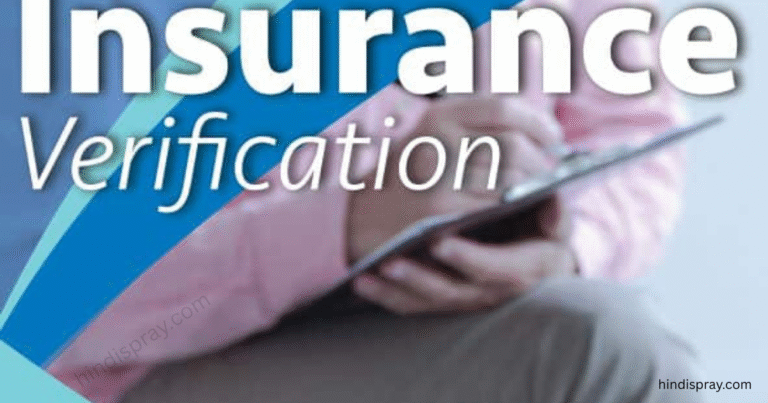Insurance plays a vital role in ensuring financial protection and access to necessary services—especially in healthcare, auto, and business sectors. But while having insurance is essential, simply holding a policy isn’t enough. One critical process that supports seamless coverage and service is insurance verification.
This article dives deep into what insurance verification is, how it works, and why it is crucial not only for consumers and patients but also for providers, businesses, and insurers. Whether you’re a policyholder, healthcare provider, or business owner, understanding insurance verification can help you avoid delays, denied claims, or unexpected costs.
Understanding Insurance Verification
What Is Insurance Verification?
Insurance verification is the process of confirming that an individual’s insurance policy is active, valid, and provides the required coverage for specific services or treatments. This verification ensures that the service provider (like a doctor’s office or auto repair shop) will be reimbursed by the insurance company for services rendered.
Who Performs Insurance Verification?
- Healthcare providers before medical appointments or treatments.
- Auto repair centers when a vehicle is involved in an accident.
- Businesses verifying a contractor’s or vendor’s liability coverage.
- Insurance agents and brokers as part of policy management or claims processing.
Verification may involve checking with the insurer via phone, email, web portals, or automated verification systems.
The Core Elements of Insurance Verification
Key Details Verified
During the verification process, the following information is typically confirmed:
- Policyholder’s name and ID number
- Policy status (active/inactive)
- Coverage type (e.g., medical, auto, liability)
- Effective and expiration dates
- Copay, deductible, and coinsurance details
- Covered services and exclusions
- Provider network status (in-network or out-of-network)
Methods of Verification
- Manual Verification
- Done by contacting the insurer directly via phone or fax.
- Time-consuming but sometimes necessary for complex cases.
- Electronic Verification (e-Verification)
- Uses integrated software to confirm insurance in real time.
- Common in healthcare and retail pharmacy environments.
- Third-Party Services
- External agencies or billing companies verify insurance for providers or organizations.
Why Insurance Verification Is Important
For Individuals and Policyholders

- Avoid Surprise Bills: Verification ensures you know what services are covered and what you’ll owe.
- Speed Up Service: Confirmed coverage means fewer delays during appointments or service calls.
- Prevent Denied Claims: Knowing your coverage beforehand reduces the risk of paying out-of-pocket for uncovered services.
Example: A patient receives treatment without knowing their insurance was expired—resulting in a large unexpected medical bill.
For Providers and Businesses
- Guarantee Payment: Verifying coverage means providers are more likely to be reimbursed.
- Reduce Claim Rejections: Inaccurate or missing insurance data is a common reason for claim denials.
- Improve Operational Efficiency: Accurate verification reduces rework, billing errors, and customer disputes.
In medical practices, incorrect insurance information can lead to weeks of revenue delay.
For Insurers
- Protect Against Fraud: Verification prevents unauthorized use of insurance.
- Ensure Contract Compliance: It ensures that the insured and provider are operating within agreed-upon terms.
- Improve Data Accuracy: Ensures that policies and billing information are up-to-date.
Insurance Verification in Healthcare
The Role in Medical Settings
In healthcare, insurance verification is an essential part of the revenue cycle. It’s performed before services are rendered—ideally during scheduling or check-in—to confirm:
- The type of plan (HMO, PPO, Medicaid, Medicare)
- Coverage for specific procedures (e.g., surgery, diagnostic imaging)
- Any pre-authorization or referral requirements
Consequences of Inadequate Verification
- Delayed or denied claims
- Patient dissatisfaction due to surprise costs
- Lost revenue for the provider
- Increased administrative burden
A 2022 report by MGMA found that up to 35% of denied claims stem from eligibility or coverage issues that could have been avoided with proper verification.
Insurance Verification in Auto and Property Claims
Why It Matters for Vehicle Repairs or Damage Claims
When you file an auto or property claim, the insurance company needs to verify:
- Whether you had active coverage at the time of the incident
- What type of damage is covered (collision, liability, comprehensive)
- Whether the claim falls within policy limits and deductibles
Repair shops and service centers also use insurance verification to confirm whether they’ll be reimbursed and what repairs are allowed.
In accident cases, verifying both parties’ insurance helps determine liability and who pays.
Challenges in Insurance Verification
Common Obstacles
- Outdated Information
- Patients or clients may provide old or expired policy details.
- Coverage Changes
- Policies frequently change due to job changes, renewals, or plan adjustments.
- Complex Policy Language
- Understanding what’s covered requires interpreting technical jargon and fine print.
- Limited Provider Access
- Some insurance companies restrict data access or require time-consuming verification steps.
Solutions and Best Practices
- Use automated verification systems to save time and reduce errors.
- Train administrative staff to double-check information at every visit or transaction.
- Encourage clients and patients to update their insurance details regularly.
- Maintain direct contact with insurance providers for faster resolution.
Legal and Compliance Considerations
HIPAA and Data Privacy (for Healthcare)
- Insurance verification involves personal and medical data.
- Providers must comply with HIPAA regulations to ensure patient privacy.
- Data encryption, secure portals, and trained staff are essential for compliant verification.
Fraud Prevention
- Insurance fraud can occur if fake or invalid policies are submitted.
- Verification helps identify inconsistencies, reducing the chance of fraudulent claims.
- Insurers may use machine learning and data analytics to flag suspicious verifications.
Best Practices for Smooth Insurance Verification
For Providers and Businesses

- Verify insurance before every service—not just the first time.
- Maintain a centralized database of verified client policies.
- Document all verification steps and outcomes in the client record.
- Stay updated on payer-specific rules and portal access.
For Policyholders
- Always carry up-to-date insurance cards or policy numbers.
- Ask questions: “Is this treatment covered?” “What will I owe?”
- Notify your provider or vendor when your policy changes.
- Check your insurance portal regularly for updates.
Also Read: Understanding Insurance Exclusions: What’s Not Covered?
Conclusion
Insurance verification is more than just a background task—it’s a critical step that ensures transparency, efficiency, and financial security for all parties involved. Whether you’re a healthcare patient, policyholder, auto customer, or business, understanding how insurance verification works can help you avoid billing surprises, reduce denied claims, and receive the services you’re entitled to.
In an increasingly digital world, leveraging technology and maintaining communication between providers, insurers, and clients makes this process more seamless and reliable. Verification is not just a best practice—it’s a necessary safeguard in the insurance lifecycle.
FAQs
1. What is the main purpose of insurance verification?
Insurance verification ensures that an individual has active coverage and that the policy covers the requested services. It helps providers confirm payment and reduces the risk of claim denials.
2. How long does the verification process usually take?
Manual verification can take a few hours to a day, while electronic verification may take a few minutes if the insurer supports real-time data access.
3. Can services be denied if insurance isn’t verified?
Yes. Many providers may delay or deny services until insurance is verified, especially for non-emergency procedures or high-cost services.
4. What happens if a claim is submitted without proper verification?
It may result in claim denial or partial reimbursement, leading to delays in payment and potential financial responsibility falling on the policyholder.
5. Is insurance verification required for emergency services?
In most cases, emergency services must be rendered immediately, regardless of verification status, but providers will still perform verification afterward to secure payment.

